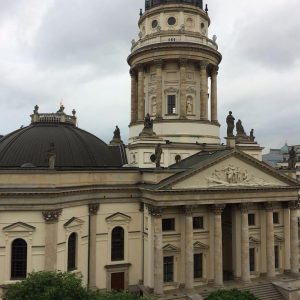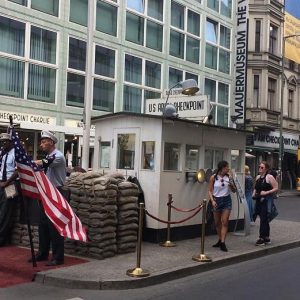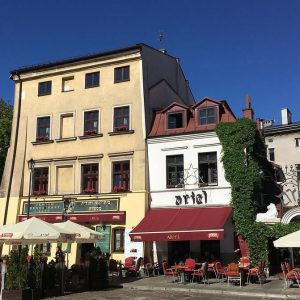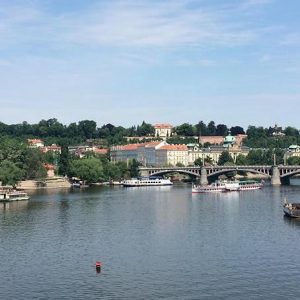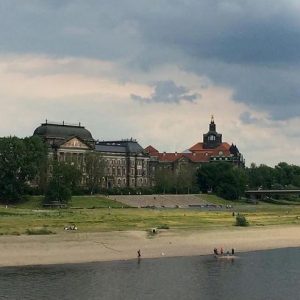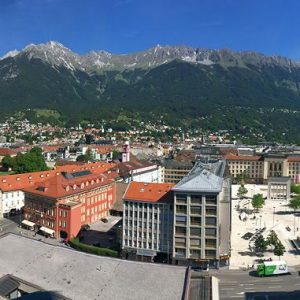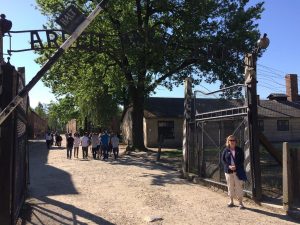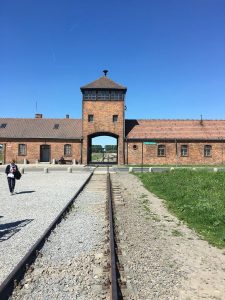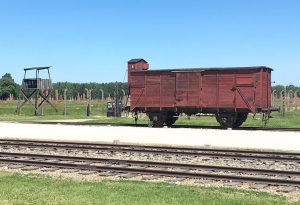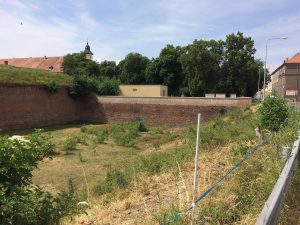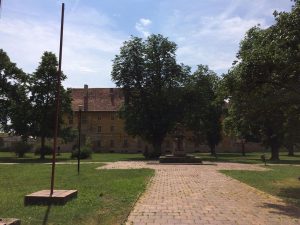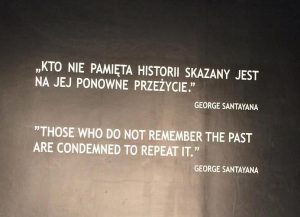Tag Archives: Poland
The Beauty of Eastern Europe
This year’s travels began in Berlin, specifically what was formerly East Berlin. A few blocks from our hotel is the iconic “Checkpoint Charlie,” the point where East and West Berlin met during the Cold War. The area has colored piping that helps to visualize where the Berlin Wall existed. This part of the city is a combination of the old and new, shoppes beside of old churches for example.
After a short visit that included a “Third Reich” day tour concluding with an unexpected sighting of German Chancellor, Angela Merkel, we headed on to Poland. After 30 minutes of a very rough road, we merged into a nice highway and the rather flat farmlands of Northwest Poland. We stayed in Krakow more as a base to travel to Auschwitz rather than to tour the city itself. In fact our hotel was several miles away from downtown. It was quite charming though. We managed to find parking to eat in the Jewish district but were not successful when wanting to see the old section of town or the River Vistula.
Onward to the Czech Republic, specifically Prague. The area was similar to Poland with a few more rolling hills. We stayed in the Old Town and my photos do little to show the beauty of this area, street after street of colorful old buildings.
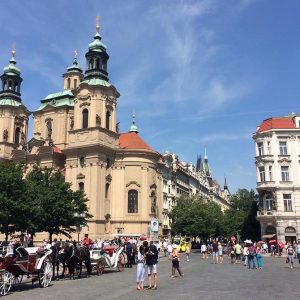
A glimpse into the Old Town Square, site of the famous astronomical clock that unfortunately was covered for restoration
We traveled from Prague two hours northwest to Dresden, Germany, the site of much bombing from the allies during WWII. I was surprised by how the German people recovered the stones and began restoration of the century years old buildings. Much of it came after the end of the Cold War and still continues today. Again, we were fortunate to find a hotel in the Old Town along the Elbe River.
We found the people in all three countries to be friendly and helpful despite language barriers. The food was excellent. I am not a fan of some of the Eastern European gravies but that was a minor problem. ALL had delicious sweets, so dessert was always a treat.
The Past Meets the Present
After many years of trying to understand, I arrived at Auschwitz, the place of horror described in so many of the books I have read. Renown author Elie Wiesel’s words from Night come to mind, “In front of us, those flames. In the air, the smell of burning flesh. It must have been around midnight. We had arrived. In Birkenau.”
Due to the nature of the visit my reflections have taken time. Returning to my hotel in Krakow, I fell into bed and didn’t awake for twelve hours, not a common practice for me. My thoughts keep returning to the site that on a beautiful sunny day seemed harmless.
Located in Poland by the town of Oświęcim, the Germans renamed the area that is comprised of two large camps and several sub-camps. Auschwitz I is characterized by the infamous “Arbeit macht frei” sign that tells everyone who enters “Works sets you free,” though most of the time freedom came only with death. This camp is comprised of brick barracks that were initially home to political prisoners and Poles. Today they hold artifacts that teach of the daily life inside the place of terror.
Within a few yards of the the camp and the gas ovens is the quarters of the longest serving camp commander Rudolf Höss, whose children played while men and women were tortured and killed.
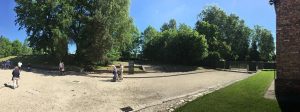
House is to the far right behind trees, camp is just behind the photographer, and the ovens are to the far left.
Auschwitz II, better known as Birkenau, was created to meet the needs of the Nazi’s final solution. A train track divides the women’s and men’s wooden barracks and ends a short distance from the gas ovens and crematoria. This is where selections were made and for most of the 1.3 million who entered the camp, their final stop. As with many of the things I have seen, the place is smaller than I’d imagined. It boggles the mind to think of the 1.1 million Jews, Poles, Soviets, Roma, Jehovah’s Witnesses and others who were forced to enter and ultimately murdered introduced with these words, “You are now in Auschwitz Concentration Camp and the only way out of her is through the crematory chimney.” Karl Fritzsch (SS-Hauptsturmführer)
Five and a half hours northwest in the Czech Republic is Terezin or as the Germans called it Theresienstadt. Terezin was built as a fortress city in that latter part of the 18th Century and today is still surrounded by a grassy moat. The entire town was converted into a ghetto for Jewish families. The moat was used to grow food for the German workers while the Jewish citizens starved.
The camp is unique in that many children lived there. Schools were set up and the children left behind evidence of their existence through writings and drawings. A cultural center attempted to create a life for the citizens with plays and musicals being performed. When the International Red Cross asked to see a concentration camp this is where they were sent. Some of the residents tried to smuggle artwork that depicted the real conditions the prisoners faced but their attempts failed. The drawings weren’t found until after the war and the heroic artists were tortured and killed.
Most of the residents of Terezin were eventually sent to Auschwitz. When the Russian troops advanced some of the Jewish prisoners were returned to Theresienstadt where a Typhus epidemic took many of their lives.
The lesson in all of this is to remember. Remembering ensures that the victims died for something. Remembering helps us to understand that this is what happens when people fall for false words and selfishness. That this began in Germany, a nation known for their philosophical, scientific, and artistic advances is important. If it can happen there, it can happen anywhere.
One of the first steps in repeating this horror is the inclination to dehumanize classes of people. Recently liberals were called out with the statement, “They’re not even people. (1)” Nour Kteily, a psychologist at Northwestern University found that when asked about the evolution of man, “on average, Americans rate other Americans as being highly evolved, with an average score in the 90s. But disturbingly, many also rated Muslims, Mexican immigrants, and Arabs as less evolved.” This kind of thinking leads to support for ideas such as a Muslim ban, with the article concluding “People who dehumanize are more likely to blame Muslims as a whole for the actions of a few perpetrators.” (2) British politician Nigel Farage threatened that if not enough is done to fight terrorism that internment camps for Muslims might be an option. This idea was quickly supported by elements of the conservative media. (3)
The recent elections of populist candidates demonstrate that people today are comfortable listening to what they want to hear. The term fake news is often a synonym for propaganda, which remains an effective means to persuade.
1938: “I overcame chaos in Germany, restored order, enormously raised production in all fields of our national economy…I succeeded in completely resettling in useful production those 7 million unemployed who so touched our hearts…” (4)
2017: “Never has there been a president — with few exceptions, in the case of FDR, he had a major Depression to handle — who’s passed more legislation, who’s done more things than what we’ve done,” Trump said. “I think we’ve been about as active as you can possibly be at a just about record-setting pace.” (5)
So today, more than ever, it is important to remember the words of Confucius. “Study the past if you would define the future,” or Santayana.
- http://www.independent.co.uk/news/world/americas/us-politics/eric-trump-democrats-not-even-people-comments-sean-hannity-fox-news-interview-video-watch-a7777416.html
- https://www.vox.com/science-and-health/2017/3/7/14456154/dehumanization-psychology-explained
- http://www.salon.com/2017/06/09/conservative-media-call-for-internment-of-muslims-following-london-attacks_partner/
- http://www.spiegel.de/international/germany/the-fuehrer-myth-how-hitler-won-over-the-german-people-a-531909.html
- https://www.washingtonpost.com/news/post-politics/wp/2017/06/12/trump-touts-amazing-progress-basks-in-praise-of-his-cabinet/?utm_term=.b544004c232e
